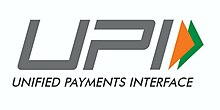Unified Payments Interface: Difference between revisions
m →How it works: South Indian Bank is repeated twice.Removed the duplicate |
No edit summary |
||
| Line 49: | Line 49: | ||
3. Enter the OTP received from your bank and create a 4-6 digit M-PIN |
3. Enter the OTP received from your bank and create a 4-6 digit M-PIN |
||
Currently, the following |
Currently, the following 32 banks<ref>{{cite web|title=UPI|url=http://www.npci.org.in/UPI_Livemembers.aspx}}</ref> provide UPI-based services: |
||
'''Banks live as PSP and Issuer:''' |
'''Banks live as PSP and Issuer:''' |
||
# |
# Allahabad Bank |
||
# |
# Andhra Bank |
||
# |
# Axis Bank |
||
# |
# Bank of Baroda |
||
| ⚫ | |||
# [[Catholic Syrian Bank]] |
|||
# |
# Canara Bank |
||
# |
# Catholic Syrian Bank |
||
# |
# DCB Bank |
||
# |
# Federal Bank |
||
# |
# HDFC Bank |
||
# |
# ICICI Bank |
||
# |
# IDFC Bank |
||
# |
# IndusInd Bank |
||
# |
# Karnataka Bank |
||
# |
# Kotak Mahindra Bank |
||
# |
# Oriental Bank of Commerce |
||
# |
# Punjab National Bank |
||
# |
# South Indian Bank |
||
# |
# State Bank of India |
||
| ⚫ | |||
| ⚫ | |||
# UCO Bank |
|||
| ⚫ | |||
# |
# Union Bank of India |
||
# |
# United Bank of India |
||
# |
# Vijaya Bank |
||
# Yes Bank |
|||
'''Banks live as Issuer:''' |
'''Banks live as Issuer:''' |
||
# |
# Central Bank of India |
||
# |
# Dena Bank |
||
# HSBC |
|||
| ⚫ | |||
# |
# IDBI Bank |
||
# |
# Indian Bank |
||
# RBL Bank |
|||
| ⚫ | |||
'''Non-Bank UPI Apps:<ref>https://www.yesbank.in/media/press-releases/fy-2016-17/yes-bank-launches-first-of-its-kind-upi-proposition-with-50-companies</ref>''' |
'''Non-Bank UPI Apps:<ref>https://www.yesbank.in/media/press-releases/fy-2016-17/yes-bank-launches-first-of-its-kind-upi-proposition-with-50-companies</ref>''' |
||
Revision as of 16:47, 14 December 2016
This article contains content that is written like an advertisement. (October 2016) |
 | |
| Industry | Finance |
|---|---|
| Founded | 11th April, 2016 |
| Founder | Reserve Bank of India |
| Headquarters | Mumbai, Maharashtra, India[1] |
| Products | Online platform for transactions |
| Parent | National Payments Corporation of India |
| Website | Official site |
Unified Payments Interface (UPI) is a system that powers multiple bank accounts (of participating banks), several banking services features like fund transfer (P2P), and merchant payments in a single mobile application.[2] UPI was launched by National Payments Corporation of India with Reserve Bank of India's (RBI) vision of migrating towards a 'less-cash' and more digital society. UPI has built on the Immediate Payment Service(IMPS) platform.
UPI platform can be used for:
- Immediate money transfer through mobile device round the clock 24*7 and 365 days.
- Single mobile application for accessing different bank accounts
- Single Click 2 Factor Authentication .
- Virtual address of the customer for Pull & Push provides for incremental security with the customer not required to enter the details such as Card no, Account number; IFSC etc.
- Bill Sharing with friends.
- Merchant Payment with Single Application or In-App Payments.
- Scheduling PUSH and PULL Payments for various purposes.
- Utility Bill Payments, Over the Counter Payments, Barcode (Scan and Pay) based payments.
- Donations, Collections, Disbursements Scalable.
- Raising Complaint from Mobile App directly.
How it works
Any Android smartphone user who has an account with a UPI-partnered bank can download a UPI app.
Registration in UPI enabled application: [3]
Steps for Registration:
1. User downloads the UPI application from the App Store / Banks website. 2. User creates their profile by entering details like name, virtual id (payment address), password etc. 3. User goes to “Add/Link/Manage Bank Account” option and links the bank and account number with the virtual id
Generating M – PIN:
1. User selects the bank account from which they want to initiate the transaction 2. Add required detail like 'Last 6 digits of Debit Card' and 'Expiry Date' 3. Enter the OTP received from your bank and create a 4-6 digit M-PIN
Currently, the following 32 banks[4] provide UPI-based services:
Banks live as PSP and Issuer:
- Allahabad Bank
- Andhra Bank
- Axis Bank
- Bank of Baroda
- Bank of Maharashtra
- Canara Bank
- Catholic Syrian Bank
- DCB Bank
- Federal Bank
- HDFC Bank
- ICICI Bank
- IDFC Bank
- IndusInd Bank
- Karnataka Bank
- Kotak Mahindra Bank
- Oriental Bank of Commerce
- Punjab National Bank
- South Indian Bank
- State Bank of India
- TJSB Bank
- UCO Bank
- Union Bank of India
- United Bank of India
- Vijaya Bank
- Yes Bank
Banks live as Issuer:
- Central Bank of India
- Dena Bank
- HSBC
- IDBI Bank
- Indian Bank
- RBL Bank
- Standard Chartered Bank
Non-Bank UPI Apps:[5]
- Alphapay
- Finmo
- Jugnoo Pay
- Mypoolin
- Paysay
- PhonePe
- Splitkart
- Trupay
See also
- List of Payment Service Providers
- Payment gateway
- Merchant account
- Immediate Payment Service
- National Payments Corporation of India
References
- ^ "National Payments Corporation of India". Npci.org.in. Retrieved 16 March 2011.
- ^ "Unified Payments Interface". www.npci.org.in. Retrieved 11 July 2016.
- ^ "Unified Payments Interface". NPCI.
- ^ "UPI".
- ^ https://www.yesbank.in/media/press-releases/fy-2016-17/yes-bank-launches-first-of-its-kind-upi-proposition-with-50-companies
External links
- AwesomeUPI - List of links to official UPI bank apps.
- UPIAppDownload - List of UPI Apps with Download Links.
